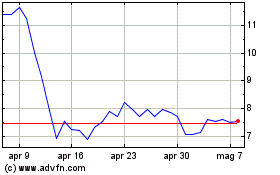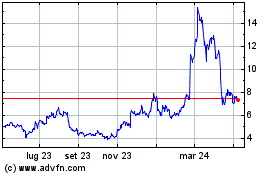Ethereum Inflation Surge Casts Doubt On “Ultrasound Money” Claim: Report
05 Ottobre 2024 - 11:00AM
NEWSBTC
According to the latest Binance Research report, the Ethereum (ETH)
issuance rate continued to rise in September 2024, raising concerns
about the digital asset’s “ultrasound money” claim. Ethereum
Issuance Rate Continues To Surge In its October 2024 Monthly Market
Insights report, Binance Research highlighted that the ETH issuance
rate continued its ascent in September, moving away from its
previously deflationary status. Related Reading: Is Ethereum Primed
For Surge? Analyst Reveals Key Levels to Watch For A $8,100 Rally
The second largest digital asset by reported market cap had a
30-day annualized inflation rate of approximately 0.74%, a level
not observed in the last two years. The sharp uptick in ETH supply
inflation has questioned its “ultrasound money” positioning.
Interestingly, the term “ultrasound money” draws inspiration from
Bitcoin’s (BTC) “sound money” narrative. While BTC’s supply is
capped at 21 million, ETH’s supply can become deflationary,
theoretically increasing scarcity and protecting it from
inflation-driven erosion of purchasing power. Ethereum’s high
issuance rate could be attributed to several factors, including low
mainnet on-chain activity, leading to a low transaction fee and,
consequently, lower ETH burn rates. In 2021, Ethereum core
developers implemented EIP-1559, which introduced a fee-burning
mechanism that aimed to reduce ETH’s circulating supply, thereby
creating deflationary pressure on the token. However, with
declining mainnet activity, the amount of ETH being burned is
lagging behind the ETH issuance rate, leading to a net inflationary
trend. Notably, September 2024 experienced one of the lowest ETH
burn rates since the highly anticipated Merge event, when Ethereum
transitioned from a proof-of-work (PoW) to a proof-of-stake (PoS)
consensus mechanism. Ethereum Layer-2 Solutions To Blame For Low
ETH Burn Rate? The report points to March 2024 as the starting
point of Ethereum’s inflationary trend, following the
implementation of EIP-4844 or the Dencun upgrade, which reduced
transaction costs on layer-2 scaling platforms such as Optimism
(OP), Arbitrum (ARB), Base, and Polygon (MATIC). The report adds:
As L2s cannibalized network activity throughout the year – further
impacted by broader market conditions – transaction fees and,
consequently, burned fees on Ethereum declined, with September
recording one of the lowest levels since the Merge. This has
prevented ETH from decreasing in supply to remain deflationary,
leading to the net positive daily supply changes we now see. Recent
trends corroborate the assertion above, as network activity on
layer-2 solutions grows across different metrics. For instance, a
report in July 2024 noted that daily active addresses and
transaction volume on Polygon had soared significantly. Related
Reading: Ethereum Solo Staking Made Easier? Vitalik Buterin
Supports Lower Entry Requirements Similarly, decentralized finance
(DeFi) activity on Arbitrum increased earlier this year when
decentralized exchange (DEX) Uniswap surpassed $150 billion in
total swap volume on the network. Another report found that over
48% of digital assets bridged from the Ethereum network end up on
Arbitrum, indicating users’ high trust in the layer-2 network’s
robust security and reliability. ETH trades at $2,385 at press
time, up 1.7% in the past 24 hours. Featured image from Unsplash,
charts from Binance Research and Tradingview.com
Grafico Azioni Uniswap (COIN:UNIUSD)
Storico
Da Feb 2025 a Mar 2025

Grafico Azioni Uniswap (COIN:UNIUSD)
Storico
Da Mar 2024 a Mar 2025
